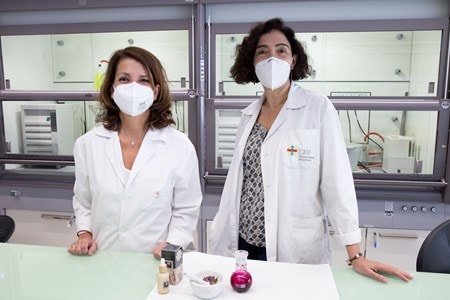
Doctors
Dolores Mingarro and Nuria Acero de Mesa from the Natural Products Research
Group at the CEU San Pablo University and Eva Bielsa Pons, from the company
Biocosmética la flor del azafrán SL, have obtained a national patent for successfully testing the antioxidant and
dermo-protective effect of saffron flower extracts. These properties help fight
cell aging and fight free radicals that cause oxidative stress.As Dr.
Muñoz-Mingarro explains, “After studying in the laboratory the discarded
saffron bio-waste, the remains of the flower once the spice is separated, , we
discovered that the extracts contained active principles showing antioxidant and dermo-protective
properties – and these could be useful in cosmetic products”.
The spice is
obtained from the deep red stigmas of the Crocus sativa L. flower (Iridaceae) and
this process, is highly labour-intensive. “The collection of
the flower in the field and the separation of the stigma, which is called
unblading, are very expensive tasks since they are totally manual. This makes
saffron the most expensive spice in the world”, explains Dr. Acero. “The
process generates a large amount of bio-waste, mainly made of tepals -
undifferentiated petals and sepals - which until now were considered useless,
and thereforediscarded,”.
The researchers recount the origins of their
research. “The study began with the University’s Natural Products research
group being approached by the head of the company, Eva Bielsa, who had been
given the contact through a former student of the CEU USP School of Pharmacy.
Eva’s father, Antonio Bielsa, had returned to the traditional cultivation of
organic saffron in Vinaceite, a village in Teruel, and brought us samples of
the floral remains for analysis.We did not hesitate to help them as there was the possibility of finding a use
for this bio-waste”. And now they have a national patent and are waiting for
their findings to be published.
Eva Bielsa, believes the properties of the extracts
of saffron floral waste could be made use of in the world of cosmetics. As a result, a Biocosmetics line
has been created -Saffron treasure- and is
currently being commercialized. The product places value on ??the floral
bio-residue of saffron through the use of natural resources. whilst also
displayingcommitment to the environment, tradition, and sustainable
agriculture, "As researchers, we are very satisfied with this
collaboration, because it implies the creation of a sustainable product and
allows the use of biological remains that would otherwise be worthless",
highlights Nuria Acero.